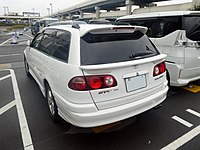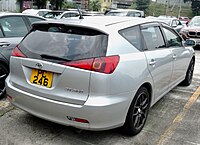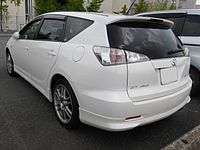Toyota Caldina
| Toyota Caldina | |
|---|---|
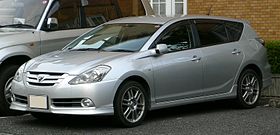 2005 Toyota Caldina ZT (AZT246W, Japan) | |
| Overview | |
| Manufacturer | Toyota |
| Production | November 1992 – June 2007 |
| Body and chassis | |
| Class | Compact car |
| Layout | |
| Chronology | |
| Predecessor | |
| Successor | Toyota Avensis wagon/estate (T270) |
The Toyota Caldina (Japanese: トヨタ・カルディナ, Toyota Karudina) is an automobile manufactured by Toyota for the Japanese market from 1992 to 2007. It replaced the Corona and Carina wagons, and was sold at Toyota Store and Toyopet Store locations in Japan. While the Caldina has never been officially exported by Toyota, its All-Trac 4WD capability and large capacity have made it a popular grey import in Australia, New Zealand, Russia and many South American countries. When it was discontinued in 2007, the T270 series Avensis wagon/estate assumed its market position.
According to Toyota, the name "Caldina" is inspired by the Italian (and English) adjective "cardinal", meaning "essential" or "fundamental".[1]
First generation (T190; 1992)
| First generation (T190) | |
|---|---|
 1992 Toyota Caldina (pre-facelift) | |
| Overview | |
| Also called | Toyota Corona/Carina E (T190) |
| Production |
|
| Body and chassis | |
| Body style | 5-door station wagon/van |
| Powertrain | |
| Engine | |
| Power output |
|
| Transmission | |
| Dimensions | |
| Wheelbase | 2,580 mm (101.6 in) |
| Length | 4,545 mm (178.9 in) |
| Width | 1,695 mm (66.7 in) |
| Height | 1,450–1,555 mm (57.1–61.2 in) |
| Chronology | |
| Successor | Toyota Succeed (van) |
The first-generation Caldina is a 5-door wagon and commercial van version (1992–2002) of the Corona/Carina sedan in Japan. The wagon has independent strut rear suspension while the commercial wagon has semi-independent leaf springs.
-
Toyota Caldina CZ (ST190G; facelift, Japan)
-
Toyota Caldina CZ (ST190G; facelift, Japan)
-
Toyota Caldina 2.0 TZ Aerial (ST191G; facelift, Japan)
-
Toyota Caldina 2.0 TZ Aerial (ST191G; facelift, Japan)
-
Toyota Caldina van
-
Toyota Caldina van
-
1994 Toyota Carina E XLi estate (United Kingdom)
-
1994 Toyota Carina E XLi estate (United Kingdom)
Second generation (T210; 1997)
| Second generation (T210) | |
|---|---|
 1997 Toyota Caldina 2.0 G (ST215G; pre-facelift) | |
| Overview | |
| Also called | Toyota Avensis (T220) |
| Production | September 1997 – September 2002 |
| Body and chassis | |
| Body style | 5-door station wagon |
| Powertrain | |
| Engine | |
| Power output |
|
| Transmission |
|
| Dimensions | |
| Wheelbase | 2,580 mm (101.6 in) |
| Length | 4,520 mm (178.0 in) |
| Width | 1,695–1,720 mm (66.7–67.7 in) |
| Height | 1,475–1,570 mm (58.1–61.8 in) |
| Kerb weight | 1,280 kg (2,822 lb) |
The second-generation Caldina is the Japanese version of the European Avensis wagon, launched in Japan in 1997.
The four-wheel drive models are coded ST215, and were also offered as Active Sports GT models with the 3S-GE engine. The top-of-the-line GT-T came with the turbocharged 260 PS (191 kW; 256 hp) fourth-generation 3S-GTE engine, and included a four-wheel drive system similar to the Celica GT-Four. The GT-T also came with optional electronic stability control (standard on Active Sports versions). The Aerial version features a large sunroof and contoured roof racks as standard. Weighing 1,440 kg (3,175 lb), the manual Caldina GT-T has a 0–100 km/h (0–62 mph) time of 6.4 seconds, with the automatic version only 0.1 seconds slower.[2] A refresh was given in 2000 with new plastic bumpers and plastic headlights. The mostly-plastic interior was also updated. In 2001, an extra lug was added to the turbo manifold to prevent the manifold from warping which had been a common issue on GT-T models.[3] Reliability of the GT-T engines proved to be a concern throughout the lifespan of the 3S powered GT-Ts, with spun main bearings and shattered oil pump gears being common issues amongst owners.[citation needed]
Engines for lesser models are the 1.8 L 7A-FE petrol, the 2.0 L 3S-FE petrol and the 2.2 L 3C-TE diesel. Reliability and maintenance issues combined with relative obscurity, hampered perceived resale values of the GT-T in countries outside Japan, making the GT-T a very cheap people carrier in grey markets like Australia.[citation needed]
-
2000 Toyota Caldina 2.0 E (ST215G; facelift, Japan)
-
Toyota Caldina 2.0 G 4WD (ST215G; facelift, Japan)
-
Toyota Caldina GT-T (ST215W; pre-facelift, Japan)
-
Toyota Caldina GT-T (ST215W; pre-facelift, Japan)
-
Toyota Caldina GT-T (ST215W; facelift, Japan)
Third generation (T240; 2002)
| Third generation (T240) | |
|---|---|
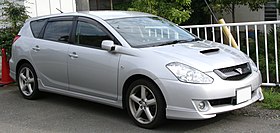 2002–2004 Toyota Caldina GT-Four (ST246W; pre-facelift, Japan) | |
| Overview | |
| Production | September 2002 – June 2007 |
| Assembly | Japan: Toyota, Aichi (Tsutsumi plant)[4] |
| Designer | Shogo Tokutake and Tetsu Endo[5] |
| Body and chassis | |
| Body style | 5-door station wagon |
| Platform | Toyota MC platform |
| Related | |
| Powertrain | |
| Engine | |
| Power output |
|
| Transmission | 4-speed automatic |
| Dimensions | |
| Wheelbase | 2,700 mm (106.3 in) |
| Length | 4,510 mm (177.6 in) |
| Width | 1,740 mm (68.5 in) |
| Height | 1,445 mm (56.9 in) |
| Kerb weight | 1,240–1,490 kg (2,734–3,285 lb) |
The third-generation Caldina launched in September 2002 was marketed as a pure sports wagon and does not share body panels with Allion, Premio and Avensis.
Engines for the Caldina are 1.8 L 1ZZ-FE, 2.0 L 1AZ-FSE and 2.0 L turbocharged 3S-GTE. Trim levels are 1.8 X, 1.8 Z, 2.0 Z, 2.0 ZT and GT-Four (the latter is coded ST246). All models have an automatic transmission and the GT-Four model only comes in a tiptronic transmission.
As a tribute to Toyota's motorsports development guru and the creator of the first GT-Four, Hiromu Naruse, a special edition Caldina GT-Four was produced, the Caldina GT-Four N Edition (N for Naruse).[citation needed] This model was equipped with several performance enhancements specified by Naruse:[6]
- Sports ABS
- Improved shocks and altered spring ratings
- Front upper strut bar
- Torsen rear LSD
- Recaro front seats and interior trim
Production of the third-generation Caldina ended in mid-2007 without a direct successor, but is indirectly replaced with the T270 series Avensis wagon/estate imported from the UK.
-
Rear view
-
Toyota Caldina ZT 4WD (AZT246W; facelift, Japan)
-
Toyota Caldina ZT 4WD (AZT246W; facelift, Japan)
References
- ^ "Data: Origin of a car's name". Toyota. 2012. Retrieved 14 April 2020.
- ^ "Toyota Caldina GT-T". 1001Moteurs. Retrieved 2015-11-27.
- ^ "3S-GTE Generations". Faster Than Jesus. Retrieved 2015-11-27.
- ^ "History of KANTO AUTO WORKS". Kanto-aw.co.jp. Retrieved 2010-07-16.
- ^ https://patents.google.com/patent/USD520909S1/en?q=~patent%2fUSD497841S1
- ^ https://www.roadandtrack.com/car-culture/a9549/toyota-caldina-gt-four-n-sports-car-of-the-new-age/












